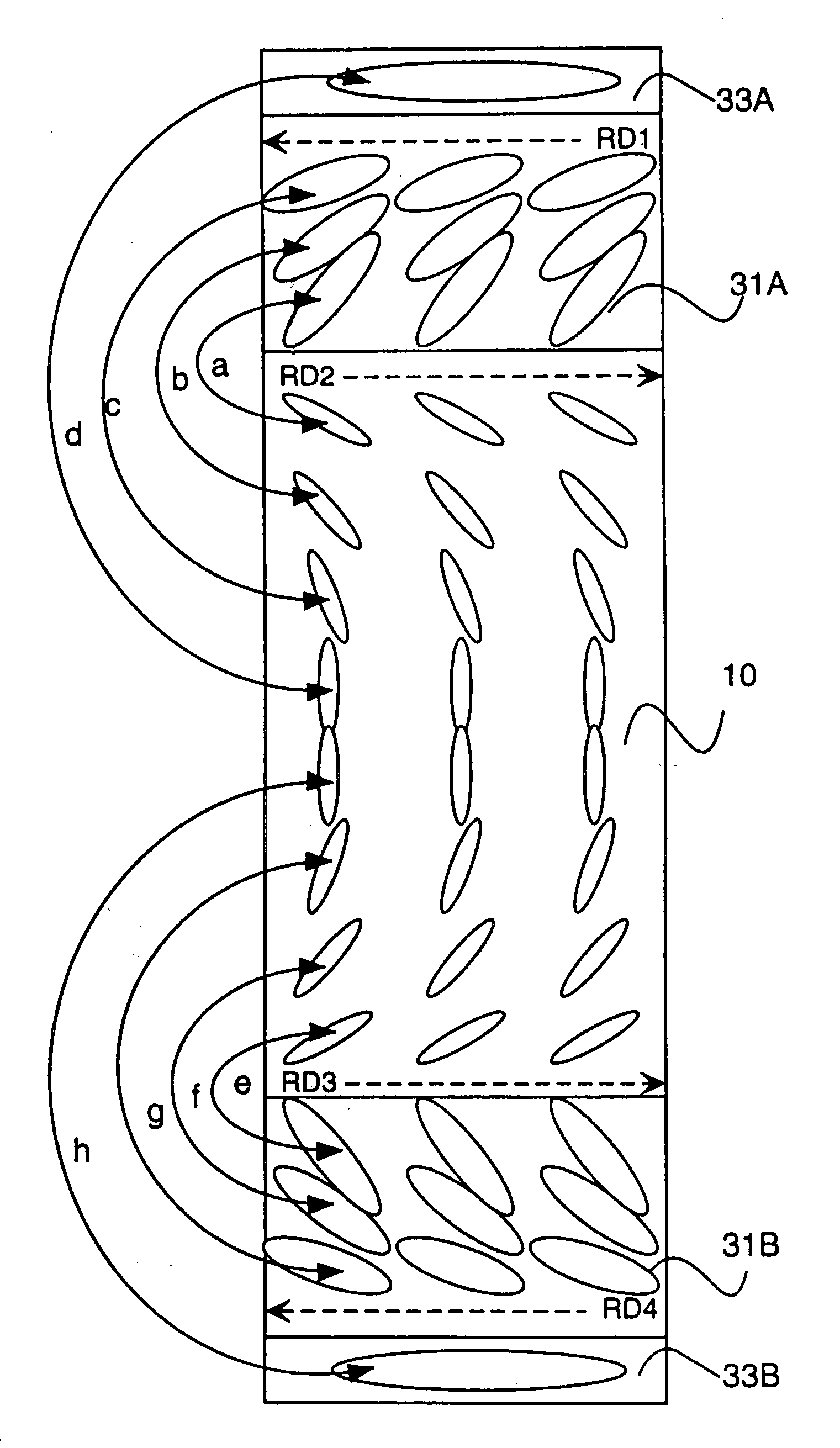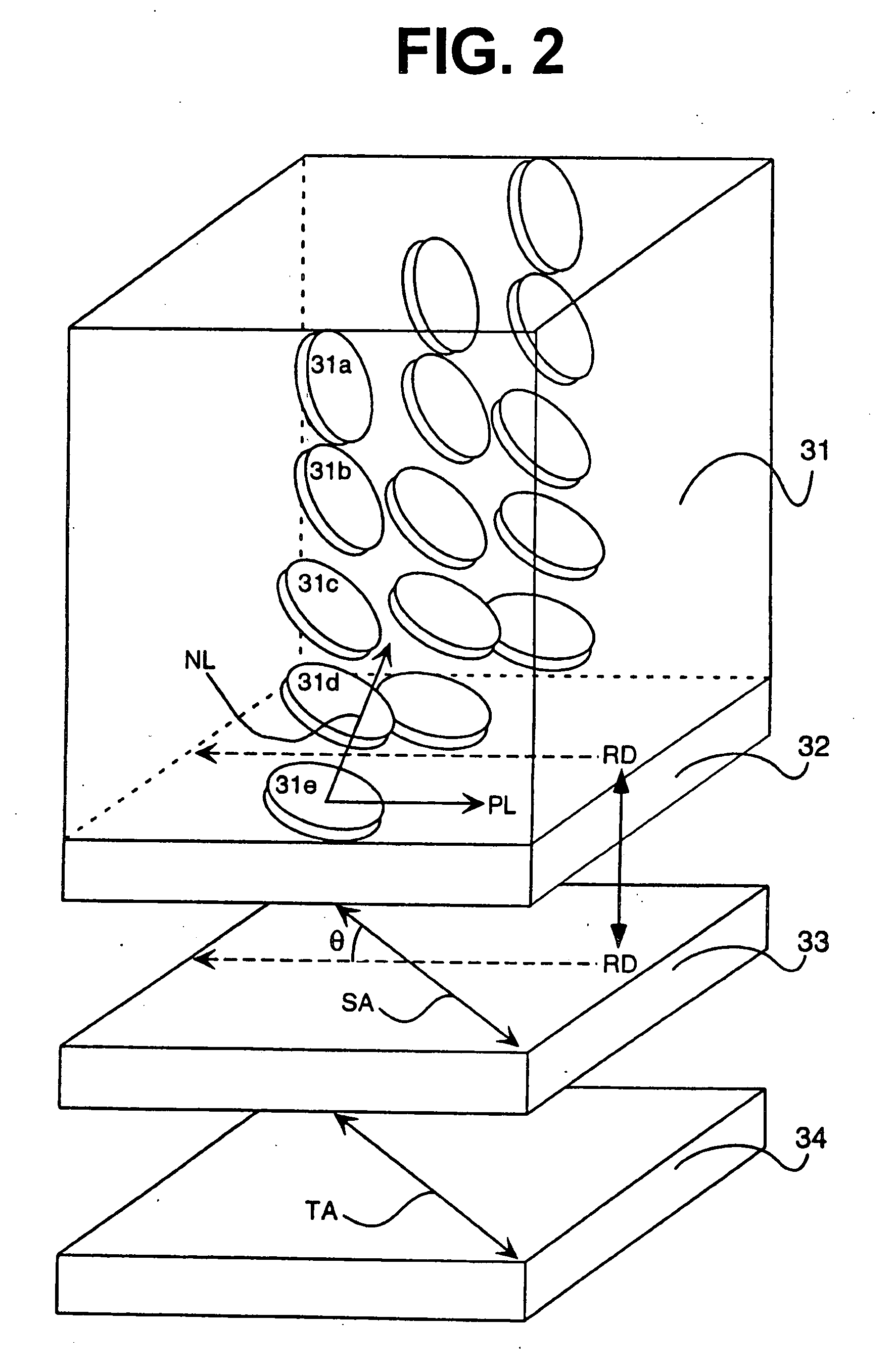Liquid crystal display having liquid crystal cell of bend alignment mode or hybrid alignment mode
a liquid crystal display and hybrid alignment technology, applied in the field of liquid crystal displays, can solve the problems that the conventional stretched birefringent film cannot fully fill the role of the optical compensatory film, and achieve the effects of improving the viewing angle character and the contrast character, high contrast, and preventing the inversion of gradation
- Summary
- Abstract
- Description
- Claims
- Application Information
AI Technical Summary
Benefits of technology
Problems solved by technology
Method used
Image
Examples
example 1
(Preparation of Second Optically Anisotropic Layer)
[0259] In room temperature, 45 weight parts of cellulose acetate having the average acetic acid content of 60.9%, 2.25 weight parts of the following retardation-increasing agent, 232.72 weight parts of methylene chloride, 42.57 weight parts of methanol, and 8.50 weight parts of n-butanol were mixed to prepare a solution (dope). The dope was cast by means of a band-casting machine of 6 m, and dried so that thickness of the dried film may be 100 μm.
Retardation-Increasing Agent
(Formation of Orientation Layer)
[0260] On the prepared second optically anisotropic layer, a gelatin-undercoating layer of 0.1 μm thickness was provided. The gelatin-undercoating layer was then coated with the following coating solution in the amount of 28 ml / m2 by means of a wire bar coater of #16. The applied solution was dried with hot air at 60° C. for 60 seconds, and then further dried with hot air at 90° C. for 150 seconds. The formed layer was then...
example 2
[0268] The procedures of Example 1 were repeated to produce a polarizing plate.
(Production of Liquid Crystal Display of Bend Alignment Mode)
[0269] On a glass plate provided with an ITO electrode, a polyimide layer was formed and the surface of the layer was subjected to rubbing treatment to form an orientation layer. Further, another glass substrate having orientation layer was prepared in the same manner. The thus-prepared two glass plates were faced to each other so that the rubbing directions were parallel to each other, and combined so that the gap between the plates might be 6 μm. A commercially available liquid crystal compound (Δn=0.1396; trade name: ZLI1132, Merck & Co., Inc.) was inserted into the gap, to prepare a liquid crystal cell of bend alignment mode.
(Production and Evaluation of Liquid Crystal Display)
[0270] The retardation values (Re1, Rth2) and Δn×d were measured by means of KOBRA21ADH (OJI SCIENTIFIC INSTRUMENTS CO., LTD.). The values of Re1, Rth2 and Δn×d ...
example 3
[0273] The procedures of Example 1 were repeated to produce a polarizing plate.
(Production of Liquid Crystal Display of Bend Alignment Mode)
[0274] On a glass plate provided with an ITO electrode, a polyimide layer was formed and the surface of the layer was subjected to rubbing treatment to form an orientation layer. Further, another glass substrate having orientation layer was prepared in the same manner. The thus-prepared two glass plates were faced to each other so that the rubbing directions were parallel to each other, and combined so that the gap between the plates might be 9 μm. A commercially available liquid crystal compound (Δn=0.1396; trade name: ZLI1132, Merck & Co., Inc.) was inserted into the gap, to prepare a liquid crystal cell of bend alignment mode.
(Production and Evaluation of Liquid Crystal Display)
[0275] The retardation values (Re1, Rth2) and Δn×d were measured by means of KOBRA21ADH (OJI SCIENTIFIC INSTRUMENTS CO., LTD.). The values of Re1, Rth2 and Δn×d ...
PUM
 Login to View More
Login to View More Abstract
Description
Claims
Application Information
 Login to View More
Login to View More - R&D
- Intellectual Property
- Life Sciences
- Materials
- Tech Scout
- Unparalleled Data Quality
- Higher Quality Content
- 60% Fewer Hallucinations
Browse by: Latest US Patents, China's latest patents, Technical Efficacy Thesaurus, Application Domain, Technology Topic, Popular Technical Reports.
© 2025 PatSnap. All rights reserved.Legal|Privacy policy|Modern Slavery Act Transparency Statement|Sitemap|About US| Contact US: help@patsnap.com



